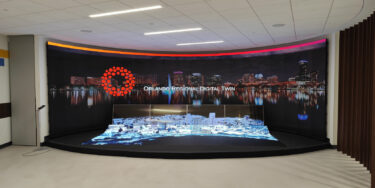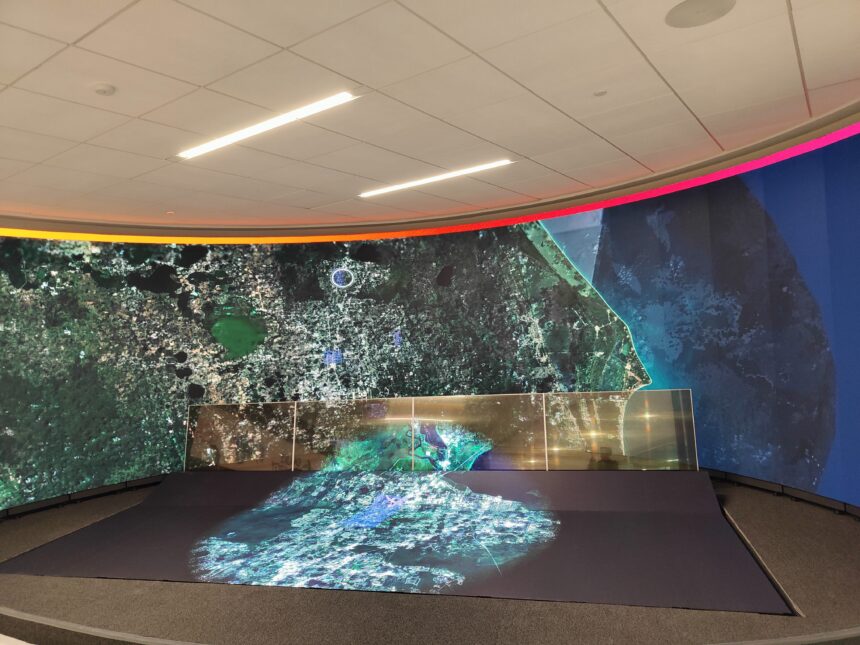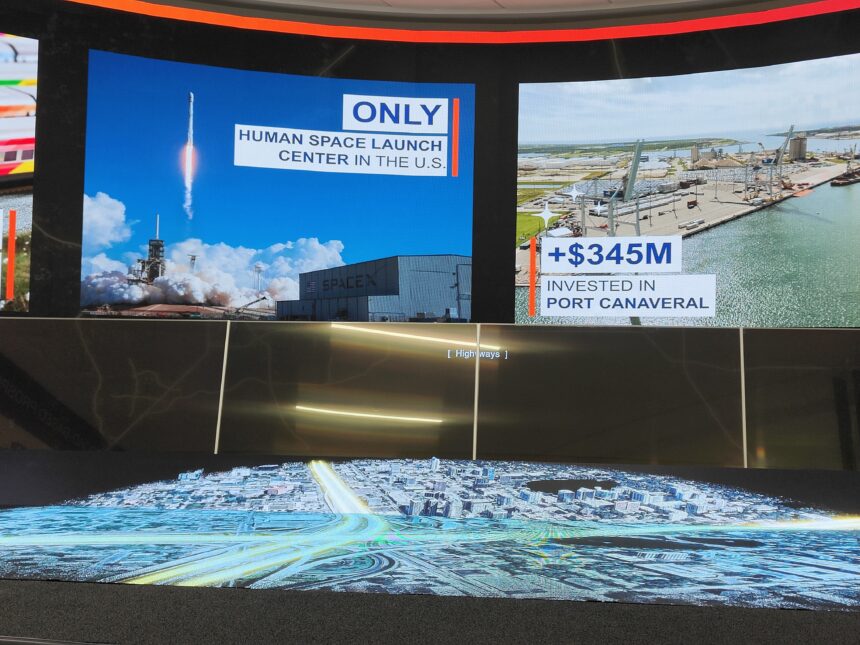Paying a Visit to the Orlando Regional Digital Twin

America's largest regional digital twin can only be seen on a mixed reality stage in Orlando, Florida. Other cities may soon build their own.
One of the largest mixed reality-enabled digital twins in the world is viewable on a special stage in the offices of the Orlando Economic Partnership (OEP), where it introduces innovators and investors to central Florida. One day soon, their twin and others like it could guide urban development and influence disaster response.
You’ve Never Seen a Digital Twin Like This
Digital twins are virtual replicas of physical people, places, and things. Something doesn’t have to be spatially navigable to be a digital twin. For example, Google Earth is a type of digital twin of the whole planet, but most of it can’t be manipulated or meaningfully navigated in 3D.
Most digital twins – at least, the ones that you can navigate as 3D models – are relatively small. For example, virtual replicas of parts or products, or even people. Small places or elements of places, like an art installment at a public park, might have a digital twin, but it is usually relatively low resolution.
The Orlando regional digital twin represents over 800 square miles of Central Florida, with over 40 square miles available in high-definition 3D. A more bite-sized experience based on the digital twin can fit on a Quest 2, but to see the real deal, I traveled to Orlando during Meta Center Global Week.
A New View of Orlando
The Orlando Economic Partnership is located on the second floor of the recently renovated 200 South Orange. Past a reception desk and office spaces, along a hallway looking out over the open-air lobby area making up the core of the building, sits the Orlando Regional Digital Twin and its mixed reality display stage.
The physical infrastructure consists of a black stage set in a curve of the building. When the twin isn’t running, it looks like it might be a stage for a modest podcast recording.
When turned on, the back wall is a giant curved monitor and the stage hosts the projection of the digital twin. A transparent wall rising from the stage in-between the viewer and the backdrop allows a 3D effect not done justice by 2D photographs.

The stage displays a focused area, with select areas available in HD 3D. The back wall shows the entire area available in the twin. Image: Jon Jaehnig | MIXED
The back wall can display anything, but when used in conjunction with the twin, it displays a map of central Florida. A halo on the map helps users understand what part of central Florida the stage displays, while blue squares on the map show those areas available for viewing in high-definition 3D.
The effect is something that looks like it should be in a sci-fi movie, perhaps with generals around it discerning how best to repel an alien attack on Washington, D.C.
So, what is it doing in an office building in Orlando?
Building a Digital Florida
“When a company is looking to develop or expand their business, we want to help them understand the value proposition of moving to Orlando,” said Trent Goodin, Orlando Economic Partnership Creative Director. “We would jump in an SUV and drive to a dozen dirt sites.”
The multi-year project saw the OEP working with Unity. Unity incorporated satellite data from HERE and Nearmap to create 3D models, and also designed the user interface for the regional digital twin, which all runs in the Unity Engine. Everything lives on the OEP’s airgap server, protecting it from outside attacks.

Members of the OEP can use the digital twin to do things like highlight specific sections of roadway to show routes to a specific location. Image: Jon Jaehnig | MIXED
Additional data comes from over 80 providers, including the OEP’s own first party data, and a mix of public and proprietary data. Layered over the foundation of the digital twin, this allows the OEP to do things like highlight alternate routes to varying sites and view sites in context of other features and figures.
Right now, this is important because companies don’t just need a building to hold their business. They want to know what kind of housing is available for their employees, and what kind of schools are available for the children of those employees.
“All of these companies that are headquartered here, they have people of every description behind them,” said Goodin. “It takes an army to run a city.”
The Future of the Orlando Regional Digital Twin
Right now, the digital twin is a very impressive 3D map capable of highlighting certain information. The goal of “phase two” is to turn it into an overview of the living Orlando that moves when Orlando moves. If that sounds ambitious, remember that the digital twin already runs on Unity, an engine designed for real-time 3D visualization.
“What we’re working on now is integrating this with APIs to display live data feeds,” said Goodin. “That will allow us to provide information like real-time traffic flows.”
Information like that is useful in the Orlando Economic Partnership’s ongoing goal of selling the idea of Orlando to companies. However, it could one day be used to do things like help the City of Orlando respond to natural disasters by doing things like understanding utility interruptions.
OEP President and CEO Tim Giuliani said that city managers already use the digital twin for things like planning construction projects. One day, the digital twin might even be able to do things like show previews of the Orlando skyline with projections of proposed buildings.
“We want to be able to give a holistic vision today, but we also want to be able to give a holistic vision going forward,” said Goodin. “We continue to work with the City of Orlando. They want a digital twin, and we want to provide that digital twin for them.”
The Future of the Orlando Regional Digital Twin … Everywhere?
The OEP built the digital twin to help secure the future of Orlando. They may also paved ground for everyone else. The OEP isn’t a tech company – it’s a chamber of commerce. And, the digital twin has earned them a lot of recognition among other chambers, including helping them earn the National Chamber of the Year Award.
“We absolutely have interest from other communities,” said Goodin, though he was reluctant to name which fellow chambers have come calling.
Note: Links to online stores in articles can be so-called affiliate links. If you buy through this link, MIXED receives a commission from the provider. For you the price does not change.